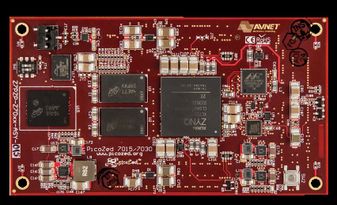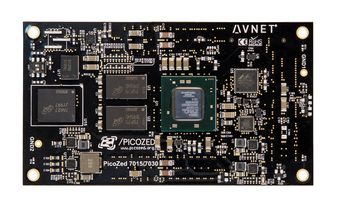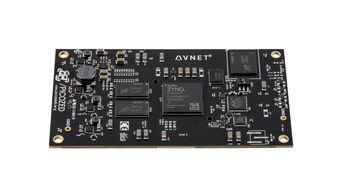PicoZed

The PicoZed module contains the core requirements to support SoC design including memory, configuration, Ethernet, USB, and clocks. It provides easy access to over 100 user I/O pins through three I/O connectors on the backside of the module. These connectors can support dedicated interfaces for Ethernet, USB, JTAG, power and other control signals, as well as the GTP/GTX transceivers on the 7015/7030 models. The transceiver based 7015 and 7030 versions of PicoZed are a superset of the 7010/7020 version, adding four high-speed serial transceiver ports to the I/O connectors. You can design your own carrier card, plug-in a PicoZed, and start application development with a proven Zynq-7000 AP SoC sub-system.
AES-Z7PZ-7Z015-SOM-I-G/REV-E
Avnet Engineering Services
PicoZed 7015 SOM - Zynq SoC based, I-grade
AES-Z7PZ-7Z030-SOM-I-G/REV-E
Avnet Engineering Services
PicoZed SOM Module Single Core QSPI Flash ARM Cortex-A9 eMMC
AES-Z7PZ-7Z010-SOM-I-G/REV-E
Avnet Engineering Services
PicoZed 7010 SOM - Zynq SoC based, I-grade
AES-Z7PZ-7Z015-SOM-I-G/REV-E
Avnet Engineering Services
PicoZed 7015 SOM - Zynq SoC based, I-grade
AES-Z7PZ-7Z030-SOM-I-G/REV-E
Avnet Engineering Services
PicoZed SOM Module Single Core QSPI Flash ARM Cortex-A9 eMMC
- Technical Documents
- Reference Designs
- Technical Specifications
- FAQS
FMC-HDMI-CAM + PYTHON-1300-C Getting Started Design, Vivado 2015.4
FMC-HDMI-CAM + PYTHON-1300-C Getting Started Design, Vivado 2016.4
PetaLinux SD Card Boot Binaries, z7010
PetaLinux SD Card Boot Binaries, z7015
PetaLinux 2020+ BSP, z7010/15/20/30 (Sharepoint site)
PetaLinux 2019.2 Enhanced BSP, z7010
PetaLinux 2019.2 Enhanced BSP, z7015
PetaLinux 2019.2 Enhanced BSP, z7020
PetaLinux 2019.2 Enhanced BSP, z7030
PetaLinux 2019.1 Standard BSP, z7010
PetaLinux 2019.1 Standard BSP, z7015
PetaLinux 2019.1 Standard BSP, z7020
PetaLinux 2019.1 Standard BSP, z7030
PetaLinux 2018.2 Standard BSP, z7010
PetaLinux 2018.2 Enhanced BSP, z7010
PetaLinux 2018.2 Standard BSP, z7015
PetaLinux 2018.2 Enhanced BSP, z7015
PetaLinux 2018.2 Standard BSP, z7020
PetaLinux 2018.2 Enhanced BSP, z7020
PetaLinux 2018.2 Standard BSP, z7030
PetaLinux 2018.2 Enhanced BSP, z7030
PetaLinux 2017.4 Standard BSP, z7010
PetaLinux 2017.4 Enhanced BSP, z7010
PetaLinux 2017.4 Standard BSP, z7015
PetaLinux 2017.4 Enhanced BSP, z7015
PetaLinux 2017.4 Standard BSP, z7020
PetaLinux 2017.4 Enhanced BSP, z7020
PetaLinux 2016.2 Compressed BSP, z7010
PetaLinux 2016.2 Compressed BSP, z7015
PetaLinux 2016.2 Compressed BSP, z7020
PetaLinux 2016.2 Compressed BSP, z7030
PetaLinux 2015.4 Compressed BSP, z7010
PetaLinux 2015.4 Compressed BSP, z7015
PetaLinux 2015.4 Compressed BSP, z7020
PetaLinux 2015.4 Compressed BSP, z7030
PetaLinux 2015.2.1 Compressed BSP, z7010
PetaLinux 2015.2.1 Compressed BSP, z7015
PetaLinux 2015.2.1 Compressed BSP, z7020
PetaLinux 2015.2.1 Compressed BSP, z7030
PetaLinux 2014.4 Compressed BSP, z7010
PetaLinux 2014.4 Compressed BSP, z7015
PetaLinux 2014.4 Compressed BSP, z7020
PetaLinux 2014.4 Compressed BSP, z7030
These tutorials provide a means to integrate several different technologies on a single platform. Using the Avnet target boards, we have the power of ARM processors, combined with the unrivaled flexibility of Xilinx programmable logic to implement custom hardware systems. We use a Linux kernel as the foundation operating system running on the processor cores which enables a very large ecosystem of software to be run on our development kits. Virtual machines can provide a very convenient Ubuntu development environment for building the hardware platform and cross-compiling software to target the Processing System.
| Specification | Description |
|---|---|
| SOC OPTIONS |
|
| MEMORY |
|
| CONNECTIVITY |
|
| EXPANSION |
|
| VIDEO DISPLAY |
|
| USER INPUTS |
|
| |
| POWER |
|
| CERTIFICATION |
|
| DIMENSIONS |
|
| CONFIGURATION MEMORY |
|
| ETHERNET |
|
| GPIO |
|
| PCIE |
|
| USB |
|
| COMMUNICATIONS |
|
| USER I/O |
|
| SOFTWARE |
|
| OTHER |
|












